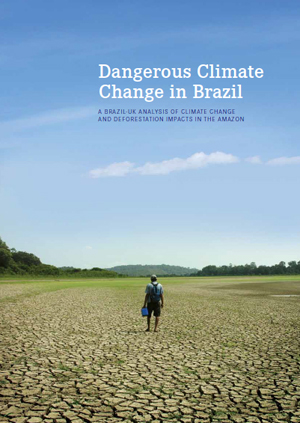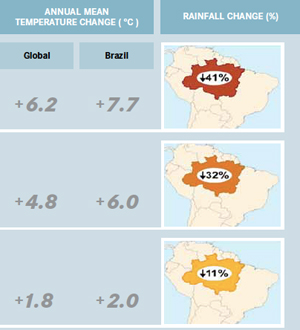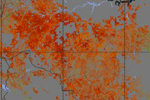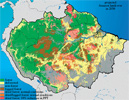
Deforestation and climate change will likely decimate much of the Amazon rainforest, says a new study by Brazil’s National Institute for Space Research (INPE) and the UK’s Met Office Hadley Centre.
Climate change and widespread deforestation is expected to cause warmer and drier conditions overall, reducing the resistance of the rainforest ecosystem to natural and human-caused stressors while increasing the frequency of extreme rainfall events and droughts by the end of this century. While climate models show that higher temperatures resulting from global climate change will threaten the resilience of the Amazon, current deforestation is an immediate concern to the rainforest ecosystem and is likely driving regional changes in climate. Augmented by both global and locally-driven climate change, forest degradation is likely to have serious consequences for the region’s inhabitants, the Amazon’s vast diversity of species, and the global carbon budget.
 Dangerous Climate Change in Brazil: A Brazil-UK analysis of Climate Change and Deforestation impacts in the Amazon [PDF] |
The INPE-Hadley Centre’s Dangerous Climate Change in Brazil project emphasizes that regional climate change caused by deforestation in the Amazon will almost certainly be amplified by global climate change. But a reduction in deforestation in the Amazon would help mitigate climate change because forests act as sinks for atmospheric carbon, which is stored in forests as vegetation grows, but released into the atmosphere when they are cleared or burned. Reducing deforestation would also boost the resiliency of the Amazon rainforest to stresses related to tree mortality such as wind, fire, and increased temperature from regional warming under climate change.
However, if widespread deforestation continues, the news is bleak. According to the study, if forty percent of the Amazon were to be deforested, the rainforest ecosystem would pass a ‘tipping point’ that would trigger a feedback loop between forest loss and climate impacts. Warming of three to four degrees Celsius in the Amazon region would likely engage a similar tipping point. Such a point may not be far off.
Climate models predict possible warming in the Amazon between two and nine degrees Celsius by the end of the century. Any warming is expected to decrease rainfall in the Amazon, particularly in eastern Amazonia. Climate model projections for 2080 suggest that if global temperature were to rise 1.8 degrees Celsius, rainfall in the Amazon would decrease by eleven percent. Should world temperature rise to 4.8 degrees Celsius, Amazonian rainfall would decrease 32 percent. Rainfall in the Amazon could decrease 41 percent if global temperature were to rise just over six degrees Celsius.
 Deforestation in Kalimantan and Sumatra |
The sensitive hydraulic cycle of the Amazon could also be at risk if even 30 percent of the forest is cleared. The rainforest recycles up to half of its rainwater, and a positive feedback loop of forest loss and decreased rainfall would threaten the stability of Amazonian ecosystems. Additional warming from climate change would accelerate the process of ecosystem alteration and its warming, drying effects.
Stressors on the Amazon rainforest could impact the whole continent. The Amazon plays a crucial role in regulating the climate of South America through its influence on the regional water cycle; therefore, large-scale deforestation in the rainforest compounded by global climate change could decrease the forest’s ability to recycle rainfall and transport moisture to other parts of the continent.
By reducing the Amazon’s capacity to absorb carbon, modifying regional water cycles, and increasing soil temperatures, deforestation and climate change could cause the Amazon to die back and be replaced with savannah-like vegetation. Such ecosystem alterations could drive major economic distress in Brazil: more than 70 percent of Brazil’s energy is produced by hydropower, and reduced rainfall related to forest death would limit the electricity supply to industrial areas. Meanwhile, dry conditions would exacerbate wild fires, which would in turn send more carbon into the atmosphere.
Even more worrisome than changes in average temperature and rainfall is the increased likelihood and frequency of extreme weather events related to climate change and regional deforestation. The Amazon has experienced two droughts and record flooding within the last five years. The 2005 and 2010 droughts fit the analysis of some climate models that projected significant drying and warming of the Amazon by the end of the century. The INPE-Hadley Centre study estimates that drought years like 2005 are now a one in twenty year event, but they could be a one in two year event by 2025 and a nine in ten year event by 2060 given current trends of climate alteration. Droughts and floods are part of the natural climate variability of the Amazon, but the risk of severe weather is expected to increase with worsening climate change. The 2005 drought greatly reduced fish yields and had a negative impact on the transportation, agriculture, and hydropower sectors, while a 2009 flood displaced thousands and led to serious public health issues related to water-borne disease.
The Brazilian government has pledged to curb deforestation in the Amazon eighty percent by 2020. Deforestation in the region did fall from 27,000 km2 in 2004 to 6,500 km2 in 2010, but the Brazilian government reported this week that deforestation has increased almost sixfold in the last year. The INPE-Hadley Centre study estimates that if large-scale weather patterns continue to be altered by climate change while deforestation increases the frequency of Amazonian drought, 55 percent of the Amazon will be lost over the next twenty years.
Related articles
Last year’s drought hit Amazon hard: nearly a million square miles impacted

(03/29/2011) A new study on its way to being published shows that the Amazon rainforest suffered greatly from last year’s drought. Employing satellite data and supercomputing technology, researchers have found that the Amazon was likely hit harder by last year’s drought than a recent severe drought from 2005. The droughts have supported predictions by the Intergovernmental Panel on Climate Change’s (IPCC) that climate change, among other impacts, could push portions of the Amazon to grasslands, devastating the world’s greatest rainforest. “The greenness levels of Amazonian vegetation—a measure of its health—decreased dramatically over an area more than three and one-half times the size of Texas and did not recover to normal levels, even after the drought ended in late October 2010,” explains the study’s lead author Liang Xu of Boston University.
Two massive droughts evidence that climate change is ‘playing Russian roulette’ with Amazon
(02/03/2011) In 2005 the Amazon rainforest underwent a massive drought that was labeled a one-in-100 year event. The subsequent die-off of trees from the drought released 5 billion tons of CO2. Just five years later another major drought struck. The 2010 drought, which desiccated entire rivers, may have been even worse according to a new study in Science, adding on-the-ground evidence to fears that climate change may inevitably transform the world’s greatest rainforest.
80% of rainforests could adversely impacted by logging, deforestation, climate change by 2100
(08/05/2010) The world’s tropical forests may suffer large-scale degradation and deforestation by the end of the century if current logging and climate change trends persist, finds a new analysis published in Conservation Letters.
(06/21/2010) The Sunday Times over the weekend retracted a column that accused the Intergovernmental Panel on Climate Change (IPCC) of making a “bogus rainforest claim” when it cited a report warning that up to 40 percent of the Amazon could be “drastically” affected by climate change. The “Amazongate” column, authored by Jonathan Leake, Science & Environment Editor of the Sunday Times, was immediately seized upon by climate skeptics as further evidence to discredit the IPCC just two weeks after it was found to be using shoddy glacier data in its 2007 climate assessment. But now the Sunday Times has removed Leake’s column from its web site and issued on apology, admitting that the Amazon claim was indeed supported by scientific research. The Sunday Times also acknowledged misconduct in the way one of the story’s sources—Simon Lewis of the University of Leeds in Britain—was quoted.
Drought threatens the Amazon rainforest as a carbon sink

(03/05/2009) Drought in the Amazon is imperiling the rainforest ecosystem and global climate, reports new research published in Science. Analyzing the impact of the severe Amazon drought of 2005, a team of 68 researchers across 13 countries found evidence that rainfall-starved tropical forests lose massive amounts of carbon due to reduced plant growth and dying trees. The 2005 drought — triggered by warming in the tropical North Atlantic rather than el Niño — resulted in a net flux of 5 billion tons of carbon dioxide (CO2) into the atmosphere — more than the combined annual emissions of Japan and Europe — relative to normal years when the Amazon is a net sink for 2 billion tons of CO2.
Global warming may drive the Amazon rainforest toward seasonal forests rather than savanna
(02/11/2009) Changes in rainfall resulting from climate change may drive the parts of Amazon rainforest toward seasonal forests rather than savanna, argue researchers writing in the Proceedings of the National Academy of Sciences
Half the Amazon rainforest will be lost within 20 years

(02/27/2008) More than half the Amazon rainforest will be damaged or destroyed within 20 years if deforestation, forest fires, and climate trends continue apace, warns a study published in Philosophical Transactions of the Royal Society B. Reviewing recent trends in economic, ecological and climatic processes in Amazonia, Daniel Nepstad and colleagues forecast that 55 percent of Amazon forests will be “cleared, logged, damaged by drought, or burned” in the next 20 years. The damage will release 15-26 billion tons of carbon into the atmosphere, adding to a feedback cycle that will worsen both warming and forest degradation in the region. While the projections are bleak, the authors are hopeful that emerging trends could reduce the likelihood of a near-term die-back. These include the growing concern in commodity markets on the environmental performance of ranchers and farmers; greater investment in fire control mechanisms among owners of fire-sensitive investments; emergence of a carbon market for forest-based offsets; and the establishment of protected areas in regions where development is fast-expanding.
Amazon rainfall linked to Atlantic Ocean temperature
(02/25/2008) Climate models increasingly forecast a dire future for the Amazon rainforest. These projections are partly based on recent research that has linked drought in the Amazon to sea surface temperatures in the tropical Atlantic. As the tropical Atlantic warms, the southern Amazon — the agricultural heartland of Brazil — may see higher temperatures and less rainfall.
Large-scale Amazon deforestation or drying would have dire global consequences
(02/21/2008) A new study shows that large-scale degradation of the Amazon, either through drying or continued deforestation, would have global consequence, including worsening climate change, causing regional vegetation shifts, and increasing dust in the atmosphere.
Global warming – not el Nino – drove severe Amazon drought in 2005
(02/20/2008) One of the worst droughts on record in the Amazon was caused by high temperatures in the Atlantic rather than el Nino. The research, published in Philosophical Transactions of the Royal Society B, suggests that human-driven warming is already affecting the climate of Earth’s largest rainforest.
55% of the Amazon may be lost by 2030
(01/23/2008) Cattle ranching, industrial soy farming, and logging are three of the leading drivers of deforestation in the Brazilian Amazon. As commodity prices continue to rise, driven by surging demand for biofuels and grain for meat production, the economic incentives for developing the Amazon increase. Already the largest exporter of beef and the second largest producer of soy – with the largest expanse of “undeveloped” but arable land of any country – Brazil is well on its way to rivaling the U.S. as the world’s agricultural superpower. The trend towards turning the Amazon into a giant breadbasket seems unstoppable. Nevertheless the decision at the U.N. climate talks in Bali to include “Reducing Emissions From Deforestation and Degradation” (REDD) in future climate treaty negotiations may preempt this fate, says Dr. Daniel Nepstad, a scientist at the Woods Hole Research Institute.
Global warming accelerates destruction of the Amazon
(12/06/2007) Deforestation and climate change could damage or destroy as much as 60 percent of the Amazon rainforest by 2030, according to a new report from environmental group WWF. The report, The Amazon’s Vicious Cycles: Drought and Fire in the Greenhouse, shows that degradation in the Amazon could release 55-97 million tons of carbon dioxide by 2030. Forest loss could also dramatically impact water cycles in the region, affecting rainfall that is critical for river flows and agriculture.